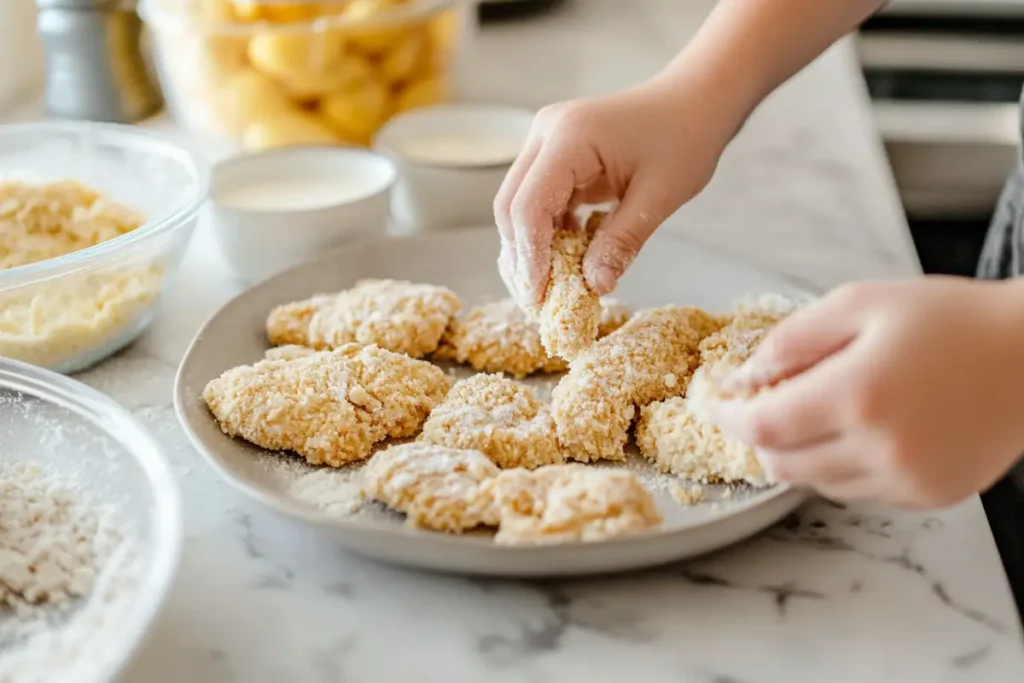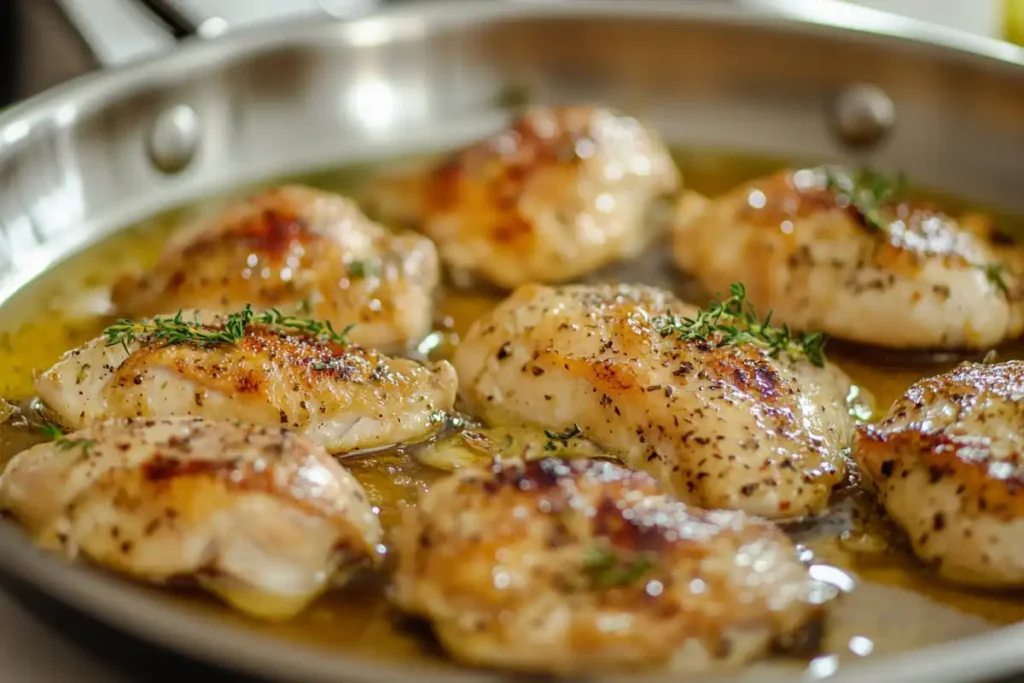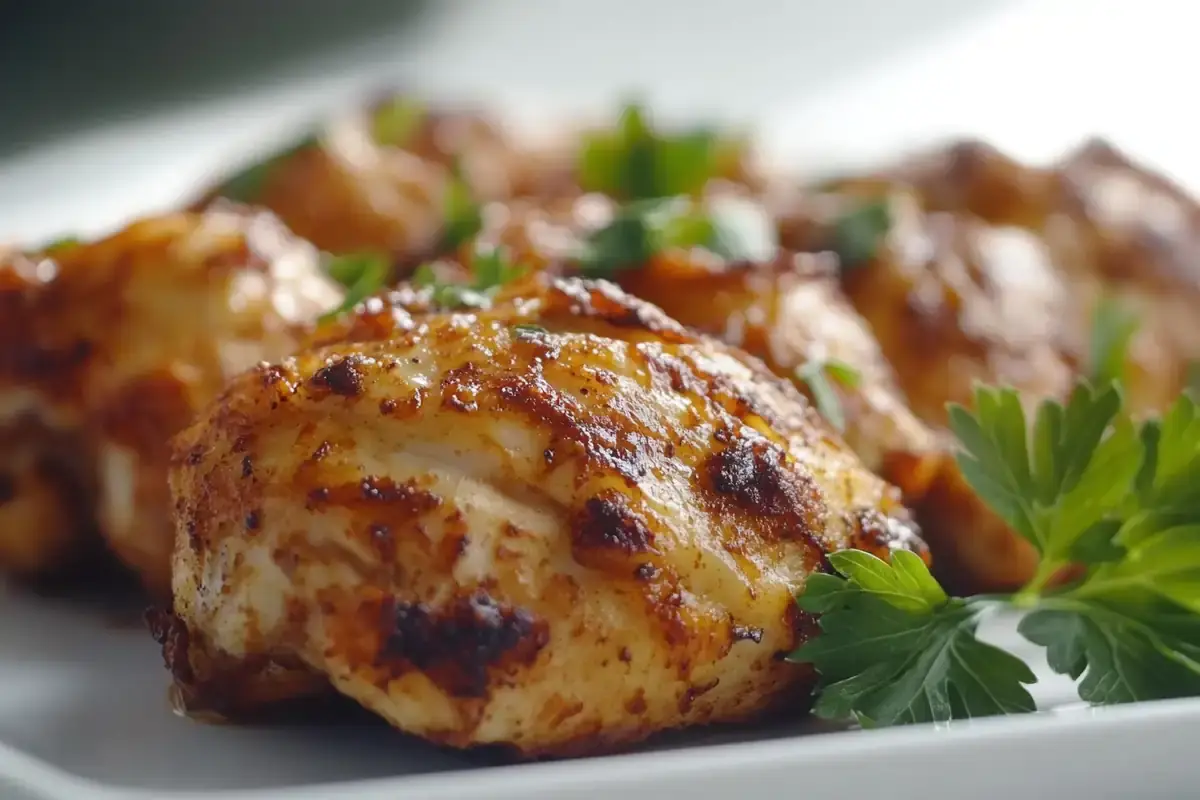What is the cause of loose breading on chicken? Many factors contribute to breading that doesn’t stick. This article explores common reasons, offering solutions for perfectly coated chicken every time.
Understanding What Is The Cause Of Loose Breading On Chicken?
Achieving crispy, well-adhered breading on chicken is a common cooking goal. However, sometimes the breading falls off, leading to frustration. Several factors can cause this issue, ranging from moisture levels to improper technique. Therefore, knowing these causes helps ensure the breading stays put on chicken.
Moisture Content: A Major Culprit
One primary reason for loose breading is excess moisture. For instance, chicken that hasn’t been properly dried will repel the breading. Additionally, any moisture on the chicken will create a barrier, preventing the breading from adhering correctly.
- Undried Chicken: If the chicken is wet after washing, the breading won’t stick. Accordingly, pat the chicken very dry using paper towels before breading it.
- Marinades and Sauces: If marinating, make sure to drain excess liquid. Furthermore, pat the chicken dry before breading, which helps the breading stick.

Improper Breading Technique and Why Breading Falls Off Chicken
The method of breading also significantly affects the final result. Generally, a rushed or incomplete breading process can lead to loose breading.
- Insufficient Flour Coating: A thin, uneven flour layer won’t adequately bind the breading. Consequently, the egg and breadcrumbs won’t adhere correctly.
- Inadequate Egg Wash: A weak or patchy egg wash hinders the breadcrumbs from attaching firmly. The egg wash acts as a glue, so using it properly is important. Similarly, ensure the egg wash covers the chicken entirely.
- Too Few Breadcrumbs: Skimping on the breadcrumbs may result in incomplete coverage. Specifically, press the breadcrumbs gently to ensure they adhere properly. Indeed, a thick coat of breadcrumbs is key.
- Rushing the Process: Pressing the breading firmly and letting it rest briefly before cooking is vital. In addition, this allows the breading to set and minimizes fall-off during cooking.

Oil Temperature: Another Key Factor for Loose Breading on Chicken
The temperature of your cooking oil affects the breading’s adhesion. Equally, oil that’s either too hot or too cold can cause the breading to detach.
- Oil Too Cold: If the oil isn’t hot enough, the breading won’t cook fast enough. Thus, it may become soggy and detach from the chicken. Specifically, the breading absorbs excessive oil if the oil is not hot enough.
- Oil Too Hot: If the oil is too hot, the breading will cook too quickly. Consequently, the inside might still be raw, and the breading will burn. The quick cooking of the outside could also make it fall off. Therefore, maintaining a stable, moderate oil temperature is necessary.
Common Mistakes and How to Avoid Them
Several common mistakes can contribute to what is the cause of loose breading on chicken. However, understanding these mistakes and how to avoid them will result in better cooking.
Rushing the Prep
Rushing the preparation is a common error. Basically, every step in the process is important, and rushing any step can affect the final product.
- Skipping Drying: Not thoroughly drying the chicken is a primary culprit. Ultimately, excess moisture makes the breading struggle to stick.
- Not Prepping the Breading Station: A disorganized breading station can lead to incomplete coating. For example, setting up three separate dishes for flour, egg, and breadcrumbs ensures smooth operation.
Why Does Breading Fall Off Chicken During Frying?
Even with proper technique, the frying process can cause problems. Accordingly, understanding the factors during cooking helps prevent this.
- Overcrowding the Pan: Overcrowding reduces the oil temperature, which creates uneven cooking. Moreover, overcrowded pans cause the chicken to steam instead of fry, making the breading fall off.
- Flipping Too Often: Flipping the chicken too much can make the breading fall off. Specifically, allow the breading to set before flipping.
- Using Too Little Oil: Shallow oil can lead to uneven cooking. Thus, ensure that the chicken is mostly submerged in oil for even cooking.
Ingredient Issues Contributing to Breading Not Staying On Chicken
The quality and type of ingredients also influence how well the breading adheres. Notably, using fresh ingredients is always the best practice.
- Stale Breadcrumbs: Old, dry breadcrumbs may not stick well. Furthermore, fresher breadcrumbs have better binding properties.
- Using the Wrong Flour: All-purpose flour is usually the best choice for breading. However, using a different type of flour might not provide the correct stickiness.
- Old Eggs: Older eggs might not provide the proper binding power. Consequently, using fresh eggs ensures the best adhesion for the breading.
Step-by-Step Guide to Prevent Loose Breading
Preventing loose breading involves careful preparation and cooking. Therefore, follow these steps for the best results.
Preparation Before Breading
- Dry the Chicken: Initially, pat the chicken dry with paper towels. Removing excess moisture is crucial for good adherence.
- Prepare the Breading Station: Set up three shallow dishes. One with flour, one with beaten eggs, and one with breadcrumbs. Afterward, this arrangement ensures easy coating.
- Season the Flour: Season the flour with salt and pepper. Specifically, this adds flavor and also helps the breading stick.
Breading the Chicken
- Coat in Flour: First, dredge each piece of chicken in the seasoned flour. In addition, make sure to shake off the excess.
- Dip in Egg Wash: Next, dip the floured chicken in the beaten eggs, making sure it is fully coated. Equally, use your fingers to help it stick.
- Coat in Breadcrumbs: Finally, coat the chicken in breadcrumbs, firmly pressing them on. Further, use your hand to push the breadcrumbs to adhere.
- Rest Before Cooking: Allow the breaded chicken to rest for 10-15 minutes before cooking. Chiefly, this allows the breading to set.
Cooking the Chicken
- Heat the Oil: Heat enough oil in a pan to medium heat. Specifically, the oil should be deep enough to partially cover the chicken.
- Do not Overcrowd: Add only a few pieces of chicken at a time. Additionally, overcrowding will lower the oil’s temperature.
- Fry Carefully: Fry each side until it is golden and cooked through. Moreover, resist flipping too often, allow the breading to crisp up and set.
- Drain Excess Oil: Remove the fried chicken and place it on a wire rack. Finally, this allows excess oil to drain away.
Troubleshooting Why Does My Breaded Chicken Have Loose Breading
Even with the best efforts, problems can occur. Therefore, here are some troubleshooting tips.
If the Breading Still Doesn’t Stick
- Double Breading: Consider double breading for a more secure coating. Repeat the flour, egg, and breadcrumb steps again. Generally, this provides a very robust coating.
- Use a Cornstarch Mixture: Mixing a little cornstarch with the flour can help breading stick. Specifically, cornstarch enhances the binding properties of flour.
If the Breading Is Soggy
- Check Oil Temperature: Make sure your oil is hot enough. A thermometer helps keep the oil at the right temperature. Specifically, using the correct temperature prevents soggy breading.
- Don’t Overcrowd the Pan: Overcrowding lowers the oil temperature, resulting in soggy breading. Conversely, cooking in batches helps keep the oil temperature consistent.
Breading Falling off During Cooking
- Let the Breading Set: Always allow the breaded chicken to rest briefly before cooking. Accordingly, this gives the breading time to adhere before it hits the hot oil.
- Use a Tongs: When flipping, use tongs to gently turn the chicken. Indeed, this prevents disrupting the breading too much.
- Keep Oil to Temperature Furthermore Keeping the oil temperature at the proper level avoids uneven cooking that might make the breading come loose.
Advanced Techniques for Breading That Stays On
Here are some advanced methods for optimal breading.
- Buttermilk Soak: Soaking the chicken in buttermilk before breading helps it stick. Basically, buttermilk tenderizes the chicken and helps breading adhere.
- Finely Ground Breadcrumbs: Using finely ground breadcrumbs can provide better coverage. Likewise, finely ground breadcrumbs tend to stick better to wet surfaces.
- Panko Breadcrumbs: Panko breadcrumbs create a very crisp crust. Ultimately, the irregular shape of panko provides a nice texture.
Understanding the Science Behind Breading
Beyond technique, understanding the science behind breading can significantly improve your results. Indeed, the way different elements interact plays a crucial role.
The Role of Flour
Flour is the foundation of any good breading. Initially, it provides a dry surface for the egg wash to adhere.
- Surface Area: Flour particles have a large surface area. Therefore, they provide many points of contact for the egg wash.
- Moisture Absorption: Flour absorbs excess moisture from the chicken. Thus, creating a better base for the next layer.
- Binding Agent: The proteins in flour help it bind with the chicken’s surface. Especially, when combined with a bit of seasoning.
The Magic of the Egg Wash
The egg wash is critical for the breading to stick. Specifically, it acts as an adhesive.
- Protein Glue: The proteins in eggs denature when heated. Subsequently, creating a “glue” that holds the breadcrumbs.
- Moisture for Adhesion: The moisture from the egg helps the breadcrumbs cling to the flour. Basically, this process binds all the layers together.
- Golden Color: The egg wash contributes to a golden-brown color when cooked. Furthermore, giving it an appealing visual effect.
The Importance of Breadcrumbs
Breadcrumbs are the final layer, providing crispiness and texture. Generally, the type of breadcrumbs you use impacts the final result.
- Surface Texture: Breadcrumbs offer a rough texture, which enhances crispiness. Moreover, the uneven surfaces help create pockets of crunch.
- Oil Absorption: The porous nature of breadcrumbs allows them to absorb oil and become crispy. However, ensure the oil temperature is correct.
- Binding to Egg: Breadcrumbs need the egg wash to stick. Consequently, they create the final protective, crisp layer.
Exploring Different Breading Options
There are many different ways to bread chicken. Accordingly, exploring these options can help you find what you prefer most.
Traditional Breadcrumbs vs. Panko
- Traditional Breadcrumbs: These create a fine, even crust. Furthermore, they work well for general breading.
- Panko Breadcrumbs: These are larger and create a light, crispy texture. Ultimately, panko is great for extra crunch.
- Texture Difference: Panko has a more open structure. Therefore, they provide a more airy and crispy result.
Flour Alternatives
- Cornstarch: Adding cornstarch to flour enhances crispiness. Specifically, it also adds binding strength.
- Rice Flour: Rice flour can be a great alternative for gluten-free options. Indeed, it also gives a nice crisp texture.
- Almond Flour: Suitable for those who are limiting carbs. Additionally, it provides a slightly nutty flavor.
Seasoning Your Breading
Seasoning your breading adds another layer of flavor. Likewise, it is an opportunity to customize your recipe.
- Salt and Pepper: Always add salt and pepper to both flour and breadcrumbs. Basically, this gives a foundational flavor.
- Garlic Powder: Adds savory notes. Furthermore, garlic powder complements many flavors.
- Onion Powder: Also adds savory depth. Moreover, it pairs nicely with garlic powder.
- Paprika: Provides a smoky flavor and a touch of color. Specifically, it works very well in fried recipes.
- Herbs: Dried herbs, like thyme or oregano, can enhance the flavor profile. Also, they add an aromatic note.
Variations for Health-Conscious Cooks
It is possible to adapt breading techniques for a healthier approach. Thus, you don’t have to miss out on the experience of crispy fried chicken.
Baking Instead of Frying
- Oven-Baked Chicken: Baking is a healthier alternative to frying. Ultimately, it reduces oil use while giving a crispy result.
- Elevated Racks: Using a wire rack in the oven promotes even cooking. Therefore, the chicken doesn’t sit in its own oil.
- High Heat: Cooking at a high temperature helps achieve a crispy coating. Especially, when combined with a preheated oven.
Healthier Breadcrumb Alternatives
- Oat Flour: Ground oats can be used as a breadcrumb alternative. Basically, oats provide fiber and a unique flavor.
- Ground Nuts: Ground almonds or other nuts offer an option for those who want a different texture. Additionally, they add some nutrients.
- Seeds: A mixture of sesame seeds, sunflower seeds, or flax seeds provides crunch and other nutrients. Moreover, these add a unique flavor.
Using Less Oil
- Air Frying: Air frying uses significantly less oil. Specifically, you still achieve a crisp exterior.
- Oil Sprays: Using an oil spray rather than pouring reduces oil use. Furthermore, this provides a light coating without adding excess fat.
- Brushing: Instead of submerging the chicken in oil, you can brush the oil onto the breaded chicken before baking or air frying. Hence, you control the quantity of oil needed.
Conclusion: Mastering Breaded Chicken
Understanding what is the cause of loose breading on chicken involves multiple aspects. Therefore, by following the correct steps and paying attention to details, you can achieve perfect breaded chicken every time. From properly drying the chicken to maintaining the correct oil temperature, each step plays an important role in breading staying on chicken. Remember the keys: dry chicken, a good breading technique, and correct oil temperature. Eventually, with practice, you’ll master the art of perfectly breaded chicken.

